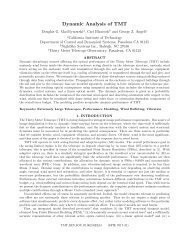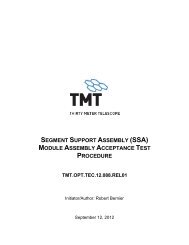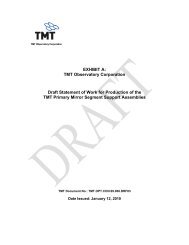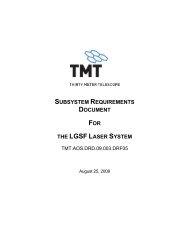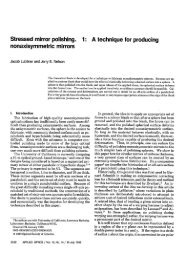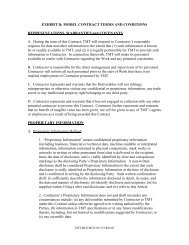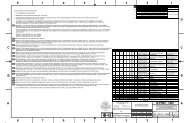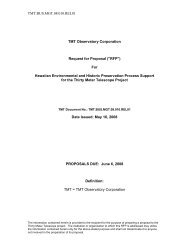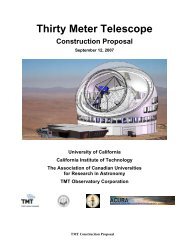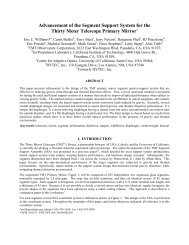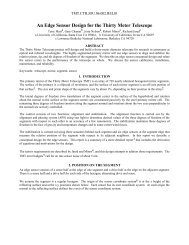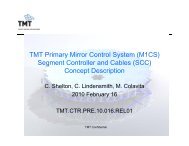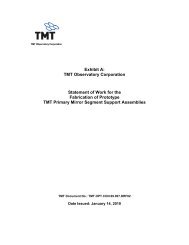Exhibit B: Specification for M2 Segment Blank - Thirty Meter Telescope
Exhibit B: Specification for M2 Segment Blank - Thirty Meter Telescope
Exhibit B: Specification for M2 Segment Blank - Thirty Meter Telescope
Create successful ePaper yourself
Turn your PDF publications into a flip-book with our unique Google optimized e-Paper software.
TMT.OPT.SPE.07.005.REL01 Page 6 of 20<br />
SECONDARY MIRROR BLANK SPECIFICATIONS 1/12/2010<br />
<br />
<br />
<br />
<br />
<br />
<br />
<br />
<br />
<br />
<br />
<br />
<br />
<br />
<br />
<br />
CTE Specimen: CTE Specimen is defined as a sample of glass or glass-ceramic material<br />
used to derive the CTE metrics in the <strong>Blank</strong>. CTE Specimens shall be taken from material<br />
immediately adjacent to the <strong>Blank</strong> material. For a <strong>Blank</strong> material whose CTE can be<br />
measured in-situ, references in this document to CTE Specimens shall include in-situ CTE<br />
measurements made at specific locations, where applicable.<br />
Defects: Defects Defects are defined as chips or cracks on the surface or cracks inside the<br />
M3 <strong>Blank</strong> material.<br />
Generating: machining the surfaces of the <strong>M2</strong> <strong>Blank</strong> by fixed-abrasive grinding or similar<br />
technique<br />
Inclusions: Inclusions are defined as any <strong>for</strong>eign matter in the <strong>M2</strong> <strong>Blank</strong> that is not the zeroexpansion<br />
material from which the <strong>M2</strong> <strong>Blank</strong> is made. For purposes of this specification,<br />
Bubbles are considered to be Inclusions.<br />
Instantaneous CTE: Instantaneous CTE is defined as the first derivative with respect to<br />
Temperature of the curve of ΔL/L plotted versus Temperature. This is illustrated in Appendix<br />
7.2..<br />
Ion Figuring: an optical figuring method in which the optical surface is shaped by<br />
bombarding it with an ion source.<br />
<strong>M2</strong> <strong>Blank</strong>: A piece of glass or glass-ceramic from which the Secondary Mirror will be<br />
fabricated.<br />
Mean Diameter of an Inclusion: the diameter of a sphere having the same volume as the<br />
Inclusion.<br />
Observatory: the facility located at Mauna Kea that will include the <strong>Thirty</strong> <strong>Meter</strong> <strong>Telescope</strong><br />
Operating Range Average CTE: The Operating Range Average CTE is defined as the<br />
average of a set of Instantaneous CTE measurements taken at the specific temperatures:<br />
-5ºC, 2ºC, and 9ºC within the Operating Temperature Range. An Operating Range Average<br />
CTE will be calculated <strong>for</strong> each CTE Specimen. The Operating Range Average CTEs of all<br />
the CTE Specimens will be averaged together to calculate the Operating Range Average<br />
CTE <strong>for</strong> the <strong>M2</strong> <strong>Blank</strong>. This is illustrated in Appendix 7.3.2.<br />
Operating Temperature Range: The Operating Temperature Range is defined as the<br />
temperature range experienced by the <strong>M2</strong> Mirror during Astronomical Observing. The limits<br />
of this temperature range are the warmest and coldest predicted temperatures that will be<br />
experienced at the <strong>M2</strong> Mirror during collection of Astronomical Data. The Operating<br />
Temperature Range is defined as -5ºC to 9ºC.<br />
Optical Surface: the convex surface of the Secondary Mirror that is shaped and polished to<br />
meet the required optical prescription requirements and that reflects the telescope light.<br />
Shop-Op Effective CTE: The Shop-Op Effective CTE is defined <strong>for</strong> each CTE Specimen as<br />
the change in length per length of the CTE Specimen between the high limit and low limit of<br />
the Shop-Op Temperature Range divided by ΔT of the Shop-Op Temperature Range. The<br />
<strong>Blank</strong> Shop-Op Effective CTE is defined as the average of all the CTE Specimens Shop-Op<br />
Effective CTEs. This is illustrated in Appendix 7.3.1.<br />
Shop-Op Temperature Range: The Shop-Op Temperature Range is defined as the<br />
temperature range experienced by the <strong>M2</strong> Mirror. The upper limit of the Shop-Op<br />
Temperature Range is the average of the temperatures that will be experienced during<br />
assembly, installation, and maintenance. The Shop-Op upper limit is defined as 20ºC. The<br />
lower limit of the Shop-Op Temperature Range is the average of the temperatures that will be<br />
experienced during Astronomical Observing on the telescope. The Shop-Op lower limit is<br />
defined as 2ºC. The Shop-Op Temperature Range is defined as 2ºC to 20ºC having a ΔT of<br />
18 ºC.<br />
Strain-Induced Birefringence: The difference (retardation) between the path length of light<br />
propagating in the direction of maximum strain and that propagating in the transverse



